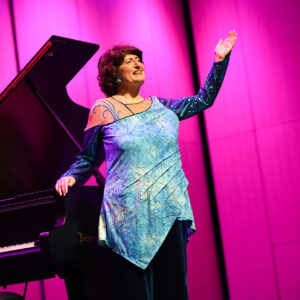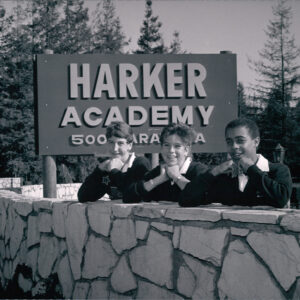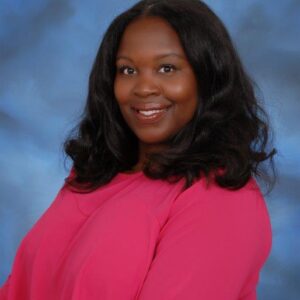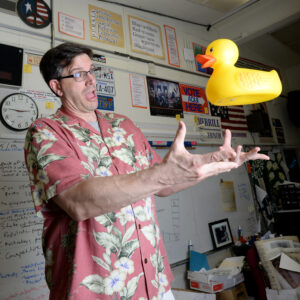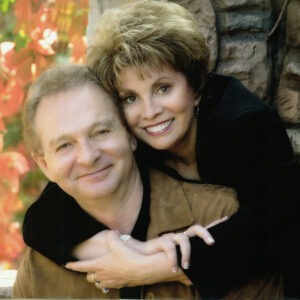This article originally appeared in the winter 2018 issue of Harker Magazine.
Words by Marla Holt
From 1893 to 2002, Harker’s boarding program was integral to its commitment to academic excellence and personal character development. From eating family-style meals and watching TV in the rec room to Bear Valley skiing trips and getting ready for school dances, the shared experiences of Harker boarders had the power to transform young lives.
“We learned from each other – through mistakes, drama, triumphs, laughter and tears,” said Wendy Tsai ’04, one of Harker’s last boarders from 2000 to 2002. Ji-won (Choi) Song ’96, who boarded in 1994-95, agreed, noting that “we built strong friendships and learned to be independent at an early age.”
Harker welcomed boarders from its earliest days as Manzanita Hall and Miss Harker’s School for Girls, when college preparatory students lived under the same roof as teachers and administrators. Handbooks from both schools referred to the boarding program as home, with students expected to “observe the ordinary courtesies of a private home” and to have the “advantage of being members of a family.” Rooms were comfortably furnished and each school was governed by a “spirit which brings about obedience to authority and an honest effort to do what is right without compulsion.”
Like Harker itself, the boarding program underwent several changes during its 109-year history. Manzanita Hall became the Palo Alto Military Academy (PAMA) in 1919 and boarded cadets in grades 1-9. Miss Harker’s dropped its boarding program in the mid-1950s when it became the Harker Day School. In 1972, PAMA and the Harker Day School merged and moved to San Jose to become the Harker Academy, which offered a boys only boarding program until 1974. At that time, the boarding program became coeducational and phased out kindergarten through grade 5 boarding while continuing to offer boarding for students in grades 6-8.
During the 1980s and 1990s, Harker housed roughly 100 to 120 boarders annually, many of whom were local students with parents who traveled frequently for business. The number of international student boarders gradually increased from about 20 percent to more than 80 percent, resulting in a greater emphasis on supporting ESL learners and a need for comprehensive weekend programming.
Harker’s last boarding students were admitted in 1998-99, the same academic year that the upper school was launched on the Saratoga campus. Only four boarders remained in the program when it closed on June 6, 2002, to accommodate Harker’s expanding upper school program.
All told, the boarding program served about 1,377 school-year boarders and 2,100 summer boarders. The students’ daily needs – from meals to academics to social and recreational activities to health care and haircuts – were met by caring, dedicated and capable staff members who acted in loco parentis. Many of the staff were coaches, teachers and bus drivers by day who lived in the dorms at night.
Joe Rosenthal, who was boarding director from 1991 to 2002 (later executive director of advancement and now executive director of strategic initiatives), noted that boarders learned the skills of independence and self-reliance, as well as appreciation of the importance of kindness in themselves and others.
“I have the greatest respect for the boarding students,” Rosenthal said in a 2002 survey of former house parents and dorm directors conducted at the closing of the boarding program. “I am a much better person because of what I have seen these children do – the expressions of friendship and kindnesses they’ve shown to each other.
Only if one lived it would one be able to know how meaningful and important the boarders have been to each other.” To celebrate the history of this beloved home for many students, we looked back at daily life for Harker boarders, particularly those who lived on the Saratoga campus.
WE ARE FAMILY
A genuine sense of family developed among the students and staff members in Harker’s boarding program, said William Jarvis ’97, who boarded from 1995 to 1997. “Harker felt more like a family than a school,” he said. “There was a strong sense of inclusivity despite the wide range of ages, interests and diverse nationalities that were represented in students all living together in close quarters.”
As in most families, the boarding program had high expectations for its students – illustrated by a clear system of behavioral rules and regulations, which served to foster a kind, respectful and positive environment.
“I treasured the trust that parents placed in our program and staff,” said Pam Dickinson, Harker’s weekend program director from 1989 to 2001, when she became the director of the Office of Communication. “It was an honor, privilege and duty to take care of their children as if they were our own (and they felt like they were). We nurtured, cared for, loved and disciplined the children as needed to help them grow into responsible, kind and considerate adults.”
Both the boarding program’s structure – including supervised study time and organized recreational active ties – and the independence-building freedom of living apart from their nuclear families helped boarders develop resiliency and the ability to make good choices.
“The social skills and self-sufficiency that I developed in the Harker boarding program have continued to be invaluable in my adult life,” Jarvis said. “The interactions and conversations I had with my peers and program staff taught me a lot about life that I would not have learned in a purely academic environment.”
JUST LIKE HOME
Day-to-day life in the boarding program reflected that of private family homes. Boarders were expected to contribute to the dorm’s upkeep by tidying their rooms and cleaning the common areas. White-glove inspections – especially when Howard Nichols, Harker’s president from 1973 to 2005, was expected to visit the dormitories – were conducted by house parents, with students competing for the Cleanest Room and Best Decorated Room awards given out at the annual Boarding Banquet.
Some boarders were better at cleaning than others, recalled Katherine Lo, weekday girls’ house parent. “My most lasting memory was the day that I was finally able to see the floor of Debora Yim’s [’04] room!”
But life as a Harker boarder wasn’t all work and no play. The rec room was a popular hangout spot for playing foosball, air hockey and Ping-Pong. Watching TV was allowed only after homework was done and not past 8 p.m. on school nights. Marta Marraccini ’84, the last boarder to live at Harker from kindergarten through eighth grade, recalled a memorable viewing of the last episode of M.A.S.H. “There wasn’t one dry eye,” she said.
Other popular activities included playing basketball and capture the flag, pool parties, movie marathons, Thursday night barbecues, nighttime sports in the gym, talent shows and special events like Monte Carlo night. Over the years, Maj. Donald Nichols’ dogs – Ajax, Babo, Klute and Dutch – were unofficial school mascots and provided love and attention to the boarders during the 23 years Nichols worked at Harker.
“Dutch, a 140-pound mastiff, had the run of the dorms and campus. At night, he slept in any room he wanted where the door was not firmly latched,” recalled Dan Gelineau in the 2002 survey of boarding staff. Gelineau went on to be assistant head of school for nonacademic affairs before he retired in 2002. He passed away in 2015.
While boarding students were expected to study and read on their own as part of their academic endeavors, staff members also regularly read stories aloud. Jeff Haugaard, boarding program director from 1976 to 1981, hosted Uncle Haugaard’s story hour in the rec room. While the older kids were in study hall, he’d read stories to the younger kids – in pajamas and robes – before bed. Later that night, he’d read the same stories over the intercom to the sixth through ninth graders as they prepared for bed. “I enjoyed hearing them say ‘Goodnight, Unc,’ as they closed their doors,” Haugaard said in the 2002 survey.
Cindy Ellis, house parent, later middle school division head, who retired in 2018, recalls that reading once helped calm students after an earthquake. “I had them buddy up in the bunk beds so that all 18 girls were in just four rooms,” she said. “I sat in the hallway and read to them until they were finally able to sleep.”
House parents nursed boarders and patched up cuts and bruises. Terry Walsh, house p rent, later assistant librarian and archivist, who retired in 2014, recalls keeping a small supply of chicken noodle soup and saltines on hand for emergencies. “I offered burnt toast and weak tea to anyone I thought was faking it,” she said.
“The staff cared passionately about our whole well-being, from getting a decent haircut to having enough time to play video games and experience nature,” said Toku Chen ’92, who boarded in 1991-92. Jarvis agreed, noting that the staff created a “comfortable social environment where you could simply be a goofy kid and feel free to express yourself.”
Students boarded at Harker for five or seven days a week. Weekends were more casual and often included excursions to Santa Cruz, Pier 39, Roaring Camp and Great America, and activities like hiking, camping, bowling, shopping and skating.
Harker’s weekend program made the school unique, Song said. “The staff did an amazing job creating a fun and nurturing program – the trips to San Francisco, malls, dinners, dance parties. I don t know how they did it, and always with so much energy!”
On Sunday mornings, many students worked at the Harker Café, an imitation Hard Rock Café at which students learned the life skills of cooking and serving food. Outfitted in T-shirts and aprons, they took orders and made eggs, bacon and fried rice for their friends (and occasionally teachers).
Many boarders have fond memories of holiday celebrations, including making Halloween costumes (that were later used in skits and plays), baking Christmas cookies and watching “It’s a Wonderful Life” at Terry and Pat Walsh’s home. Cutting down and decorating a Christmas tree for the dining room was particularly fun.
“One year there was a huge beehive in the tree,” Marraccini recalled. “You never saw Jeff [Haugaard] move so fast. The kids were running and screaming. Later we found an even better tree, cut it down and went back to the dorm like warriors after the battle.”
The night before break, everyone gathered in the rec room to drink eggnog and listen to Howard Nichols read “The Night Before Christmas” while a video fir played on the TV and Gelineau played the accordion. The house parents made sure each child had a gift to open.
“In most families, there are a limited number of adults to whom a child can turn for advice and guidance,” Dickinson said. “Our boarding students had their pick of thoughtful, caring adults in their lives.”
A boarding program based only on principles, philosophy, values and budgets is not likely to be successful. Though Harker certainly had all of those things, it also understood that a boarding program had to be about family.
“Children watch, observe, learn, feel, emulate and absorb the character and values of the adults,” Chen said. “The boarding program represented a remarkable team that shared and exhibited the same values, passion and care for others. The program went far to take care of every kid – one by one. Whenever I think about the Harker boarding life and all the great people I was with, it leaves a lifelong smile in me.”
Contributing researcher: Cindy Ellis.
Marla Holt is a freelance writer based in Minnesota.








